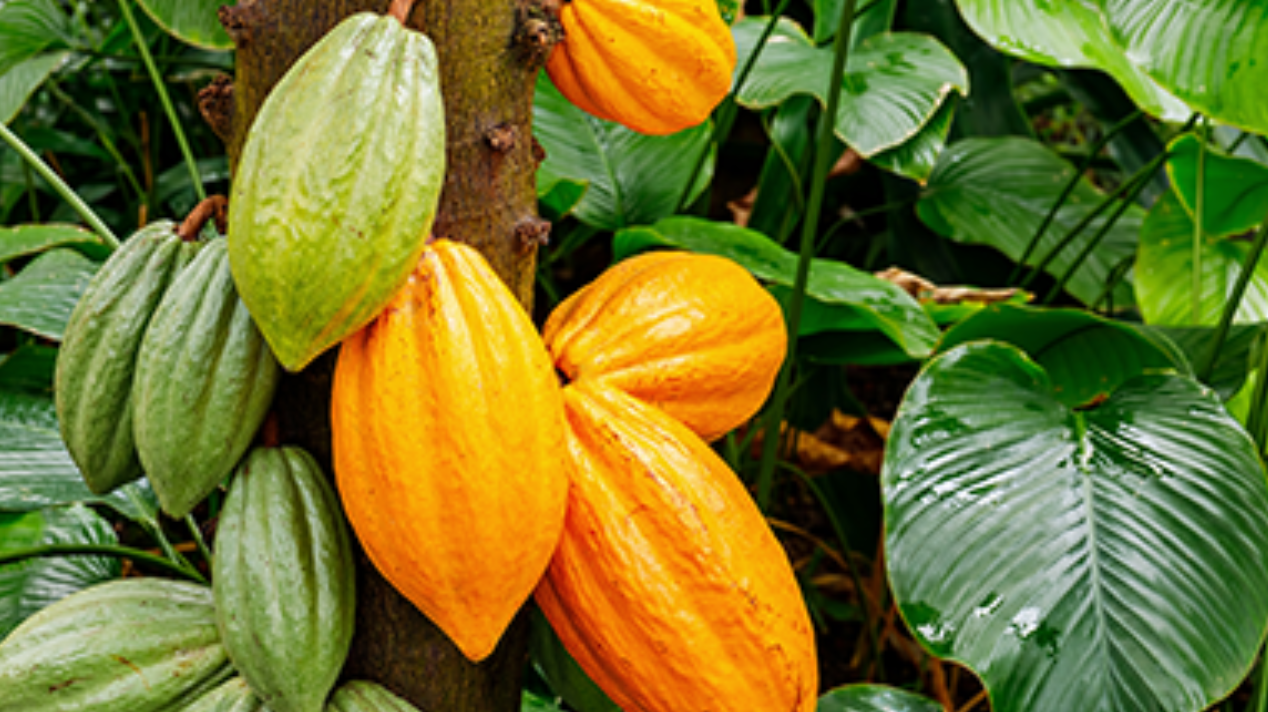
Author
TRENDING NOW
-
Complete List of African Political Leaders – 2025
-
The Ghana Cocoa Report 2024: Ghana Cocoa Industry: History, Challenges, and Future Prospects
-
Ghana’s Population Growth: Key Trends, Challenges, and Opportunities
-
The Untold Story of Pedro Alonso Niño: The Black Navigator Behind Columbus's Success
-
Top African Companies by Market Capitalization – 2025: The Continent's Economic Powerhouses Redefining Global Business
ARTICLE STATS
The Ghana Cocoa Report 2024: Ghana Cocoa Pricing Trends: Analysis of Market Dynamics and Future Projections
Explore the latest trends in cocoa pricing in Ghana, including farmgate prices, global market dynamics, and the impact of sustainability certifications. Learn how government policies and international demand influence cocoa prices.
Highlights:
- Comprehensive analysis of Ghana’s cocoa pricing trends, including historical data and future projections.
- Key statistics on domestic and international cocoa prices, as well as factors influencing price fluctuations.
- Insights into the role of government policy, global demand, and sustainability in shaping future cocoa pricing.
Ghana Cocoa Pricing Trends: Market Dynamics and Future Projections
Highlights
- Comprehensive analysis of Ghana’s cocoa pricing trends, including historical data and future projections.
- Key statistics on domestic and international cocoa prices, as well as factors influencing price fluctuations.
- Insights into the role of government policy, global demand, and sustainability in shaping future cocoa pricing.
Research Methodology
This article utilizes data from the Ghana Cocoa Board (COCOBOD), international commodity market reports, and academic studies on cocoa economics. Quantitative data on cocoa prices, production costs, and export revenues are supplemented by qualitative insights from interviews with cocoa traders, farmers, and industry experts.
Top 10 Key Statistics and Facts
- Farmgate price: The Ghanaian government set the 2023/2024 farmgate price for cocoa at ₵1,308 per 64 kg bag, or approximately ₵20,943 per metric ton.
- Cocoa export revenue: Ghana generates about $2 billion annually from cocoa exports, accounting for roughly 30% of its total export revenue.
- International cocoa prices: As of 2023, international cocoa prices fluctuate between $2,500 and $3,200 per metric ton, depending on global supply and demand dynamics.
- Price premium: Ghana’s high-quality cocoa beans command a price premium of up to 10% on the global market compared to beans from other producing countries.
- Price volatility: Over the past decade, cocoa prices have experienced 15-20% annual volatility, driven by weather conditions, geopolitical issues, and market speculation.
- COCOBOD stabilization: COCOBOD’s price stabilization fund helps mitigate the impact of global price fluctuations, ensuring more predictable incomes for farmers.
- Production costs: The average cost of cocoa production in Ghana is approximately ₵12,000-14,000 per hectare, with labor and input costs being the largest components.
- Living income differential (LID): Ghana and Côte d'Ivoire introduced a $400 per metric ton Living Income Differential (LID) in 2020 to boost farmers’ incomes and support sustainable production.
- Sustainability certifications: Certified cocoa, such as Fairtrade and Rainforest Alliance, can fetch up to 20% higher prices due to growing demand for ethically sourced products.
- Exchange rate impact: Fluctuations in the cedi-dollar exchange rate significantly affect the competitiveness of Ghana’s cocoa on the international market.
Critical Analysis of Cocoa Pricing Trends in Ghana
Cocoa pricing in Ghana is shaped by a complex interplay of domestic policies, global market dynamics, and production costs. As the world’s second-largest cocoa producer, Ghana plays a pivotal role in the global cocoa market, with cocoa prices having direct implications for millions of smallholder farmers, the national economy, and international supply chains.
Domestic Price Setting and Government Intervention: Ghana operates a regulated cocoa pricing system, with COCOBOD setting the farmgate price annually in consultation with key stakeholders, including farmer cooperatives, international buyers, and government officials. The primary goal of this system is to protect farmers from the volatility of global cocoa prices while ensuring a stable income. For the 2023/2024 cocoa season, COCOBOD announced a farmgate price of ₵1,308 per 64 kg bag (₵20,943 per metric ton), representing a significant increase from previous years due to rising global cocoa prices and domestic inflation pressures.
The government’s decision to raise the farmgate price reflects its commitment to ensuring that cocoa farming remains viable for the country’s 2 million smallholder farmers, who rely heavily on cocoa for their livelihoods. However, the challenge lies in balancing farmer income with the sustainability of COCOBOD’s pricing system, which is supported by a price stabilization fund designed to cushion the impact of global market fluctuations.
Global Market Dynamics: International cocoa prices are influenced by supply-demand dynamics, weather conditions, and geopolitical factors. Over the past decade, prices have fluctuated significantly, ranging from $1,900 to $3,500 per metric ton. Key factors driving this volatility include:
Supply disruptions: Weather-related events, such as droughts or excessive rainfall, can significantly affect cocoa production levels. Ghana’s reliance on rain-fed agriculture makes it particularly vulnerable to climate-induced supply shocks, which in turn affect cocoa prices.
Global demand trends: Cocoa demand is influenced by consumption patterns in key markets such as Europe, North America, and emerging economies in Asia. As consumer preferences shift towards higher-quality and sustainably sourced cocoa products, demand for Ghanaian cocoa has remained strong, contributing to price premiums.
Market speculation: Speculators in commodity markets often exacerbate price volatility by buying and selling futures contracts based on perceived risks in the market. This speculative activity can lead to sudden spikes or drops in prices, adding uncertainty for cocoa producers.
Living Income Differential (LID): In response to concerns about low farmgate prices and the economic sustainability of cocoa farming, Ghana and Côte d'Ivoire, which together account for about 60% of global cocoa production, introduced the Living Income Differential (LID) in 2020. The LID adds a $400 premium to each metric ton of cocoa sold from the two countries, with the aim of ensuring that farmers earn a living income.
The LID has been lauded as a groundbreaking policy aimed at addressing poverty in the cocoa sector, where many farmers struggle to make ends meet despite the high demand for cocoa. However, its implementation has faced resistance from international buyers, who argue that the LID increases the cost of cocoa and could drive up consumer prices. Additionally, while the LID has raised incomes for some farmers, its impact has been limited by global price volatility and fluctuations in demand.
Sustainability and Premium Pricing: The growing demand for sustainably produced cocoa has had a positive impact on pricing trends in Ghana. Sustainability certifications, such as Fairtrade and Rainforest Alliance, enable farmers to sell their cocoa at higher prices due to the premium placed on ethically sourced and environmentally friendly products. Certified cocoa can fetch up to 20% more on the market, and Ghana has made significant strides in promoting sustainability through COCOBOD’s programs and partnerships with international organizations.
However, certification also comes with challenges. The costs associated with meeting sustainability standards—such as investing in environmental protection measures and ensuring fair labor practices—can be prohibitive for smallholder farmers. Furthermore, not all certified cocoa commands a price premium in the market, depending on global demand and buyer preferences.
Impact of Exchange Rates: Ghana’s cocoa pricing is also affected by exchange rate fluctuations, particularly the value of the cedi against the US dollar. Since cocoa is traded internationally in US dollars, a weaker cedi makes Ghana’s cocoa more competitive on the global market by lowering the dollar price for international buyers. Conversely, a strong cedi can reduce competitiveness, as buyers may opt for cheaper cocoa from other producing countries. As such, currency volatility plays a significant role in shaping both domestic and international pricing dynamics.
Current Top 10 Factors Impacting Cocoa Pricing Trends in Ghana
- Global cocoa supply: Changes in production levels in major cocoa-producing countries, including Ghana and Côte d'Ivoire, directly impact global prices.
- Weather patterns: Climate variability and extreme weather events, such as droughts or heavy rains, can disrupt cocoa production and affect pricing.
- Demand for sustainable cocoa: Growing demand for certified cocoa products drives price premiums but also raises the cost of production for farmers.
- Market speculation: Speculative trading in cocoa futures markets contributes to price volatility and unpredictability.
- Government price stabilization policies: COCOBOD’s farmgate pricing system and price stabilization fund help mitigate the effects of global price fluctuations.
- Exchange rate fluctuations: The value of the cedi relative to the US dollar influences the competitiveness of Ghana’s cocoa exports and domestic prices.
- Living Income Differential (LID): The LID introduced by Ghana and Côte d'Ivoire impacts international buyers’ pricing strategies, while aiming to increase farmers’ incomes.
- Production costs: Rising input costs, including labor, fertilizers, and pesticides, affect the profitability of cocoa farming and influence price-setting decisions.
- Sustainability certification: The adoption of sustainability certification programs can lead to higher prices but also incurs costs for farmers.
- International trade policies: Tariffs, trade agreements, and regulations in key importing countries affect cocoa pricing and market access for Ghanaian cocoa.
Projections and Recommendations
Strengthen Price Stabilization Mechanisms: COCOBOD should continue to enhance its price stabilization fund to protect farmers from extreme price volatility in global markets. This will ensure that farmers receive more predictable incomes despite fluctuating international prices.
Expand Access to Sustainability Certifications: Increasing the number of farmers participating in sustainability certification programs will allow more cocoa producers to benefit from premium prices. COCOBOD and international partners should invest in reducing the barriers to certification, including covering the costs of compliance.
Enhance Climate-Resilient Farming: To mitigate the effects of climate variability on cocoa production, COCOBOD should expand its efforts to promote climate-smart agriculture and agroforestry. These practices will help stabilize yields and, by extension, reduce price volatility caused by supply disruptions.
Address Currency Risks: Ghana should explore strategies to manage currency volatility, including the use of hedging instruments or export diversification. By reducing the risks associated with exchange rate fluctuations, Ghana can maintain competitive pricing for its cocoa exports.
Evaluate LID Impact: The implementation of the Living Income Differential should be regularly reviewed to ensure that it is effectively raising incomes for cocoa farmers without negatively impacting international demand. Adjustments to the policy may be
necessary to balance farmer welfare with market competitiveness.
Conclusion
Cocoa pricing trends in Ghana are shaped by a variety of domestic and global factors, from government intervention and sustainability certification to market speculation and exchange rate dynamics. While Ghana has made significant progress in protecting farmers from price volatility through its farmgate pricing system and the introduction of the LID, challenges remain. By strengthening its price stabilization mechanisms, expanding access to premium markets, and investing in climate-resilient farming practices, Ghana can ensure a more stable and prosperous future for its cocoa sector.
Notes
- The data for this article were sourced from COCOBOD, international market reports, and academic research on commodity pricing.
- Statistics on cocoa pricing and export revenues were drawn from industry reports and government publications.
Bibliography
- Ghana Cocoa Board (COCOBOD). (2023). "Cocoa Pricing and Export Trends: Annual Report."
- International Cocoa Organization (ICCO). (2022). "Global Cocoa Pricing and Market Volatility."
- World Cocoa Foundation. (2021). "Sustainability and Cocoa Pricing: Impacts of Certification."
SEO Metadata
- Title: Ghana Cocoa Pricing Trends: Analysis of Market Dynamics and Future Projections
- Description: Explore the latest trends in cocoa pricing in Ghana, including farmgate prices, global market dynamics, and the impact of sustainability certifications. Learn how government policies and international demand influence cocoa prices.
- Keywords: Ghana cocoa pricing, cocoa farmgate price, cocoa export revenue, sustainability certification cocoa, global cocoa market trends, Living Income Differential cocoa

